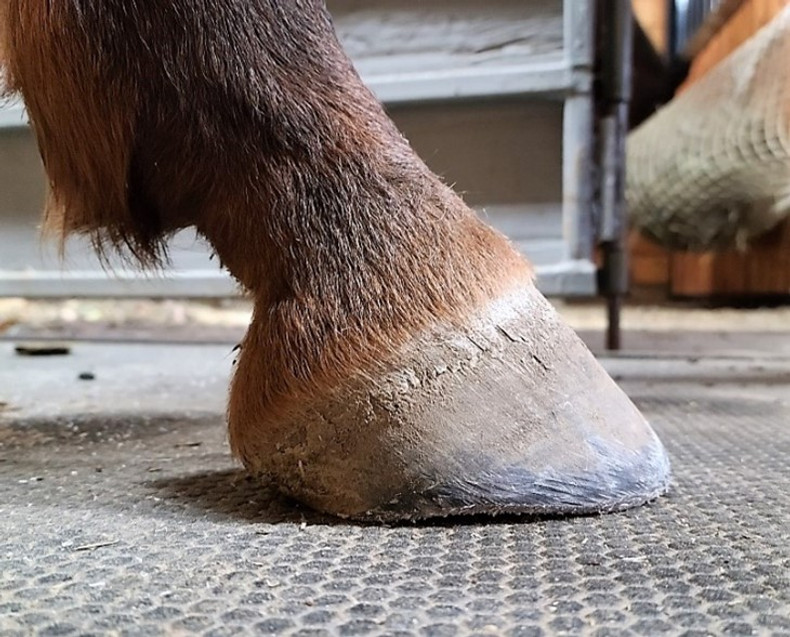Tradition
Over twenty years ago a new style of trimming horses emerged that was developed to help more horses become sound by allowing them to grow healthier hooves, optimize their form and function, and enable the horses to go barefoot. It was a big change from what we were used to, and it left a lot of horse people feeling unsure about the benefits and why their horses may not need shoes after all.
Changing traditional ways of doing anything is never easy, so let’s take a look at the barefoot trim in more detail and how it differs from conventional trimming. In this way, we can increase our understanding of what the trim actually accomplishes.
A Holistic Model
The barefoot trim is not just about hooves; it’s a method of hoof care which strives to achieve improvement in overall health as well as hoof health and soundness. Qualified barefoot trimmers recognize that hooves are part of the greater whole and that the hooves not only influence physical health but that the hooves themselves are impacted by the health of the physical body.
Thus, the barefoot trim encompasses a holistic approach to all areas of the horses’ life: living environment, diet, digestive health, levels of exercise, metabolism, and even hormonal balance. All of these factors contribute to the prevention and recovery of sore hooves including the development and maintenance of strong bare feet. So, educating the horse owner is a very important part of the job.
Traditional vs Barefoot
Holistic hoof practices differ from traditional farrier since the usual farrier trim is performed to apply a shoe and may not consider the dynamic balance of the hoof. This is referred to as a pasture trim whether the hoof is shod or not and it causes the hoof wall to carry most of the load on impact which stresses the laminae. In the barefoot approach the trim ensures that the load is carried by the wall, as well as the outside perimetre of the sole, the bars, frog, and heels. Traditionally trained farriers also leave the underside of the hoof looking “clean” by removing much of the protective tissue that the horse develops after every trim. The soles, frog, walls, and bars are cut and pared down leaving the sensitive, immature tissue exposed.
In contrast, the barefoot trimmer does not remove protective tissue. The bars are tapered, allowing them to share the load at the back of the hoof. The sole in front of the frog is left untouched in most cases. This allows a durable callous to develop for protection against rough terrain. Only loose flaps are trimmed from the frog, and all calloused healthy frog tissue is left intact as the frog is an effective shock absorber for the hoof. This approach leaves the underside of the hoof with a rugged appearance that is suitable for moving over varied terrain comfortably. The trim also bevels the lower hoof wall to mimic the wear that the horse naturally maintains if they were traveling the optimal 10-15 kilometers per day.
The holistic approach also favours a barefoot trim because the trimmers know that the function and mechanics of the hoof connect with the entire body of the horse. The underside of the hoof has proprioceptors that relay information about footing and the environment to the horse. If the hooves are shod these proprioceptors are not able to function normally.
Furthermore, the natural shape of the barefoot hoof is not flat on the underside but has a “solar arch” or “harmonic groove” along the hoof wall and outer sole. This arch mirrors the actual shape of the coffin bone which lies inside the front half of the foot. This arch allows for expansion and contraction that increases blood circulation inside both the hoof and the limb. It also improves shock absorbency and traction. A solar arch is naturally developed on barefoot horses who self-trim by moving over several kilometers daily on varied terrain. This movement results in beautiful, concave hooves with bevelled hoof walls, calloused frogs, and soles.
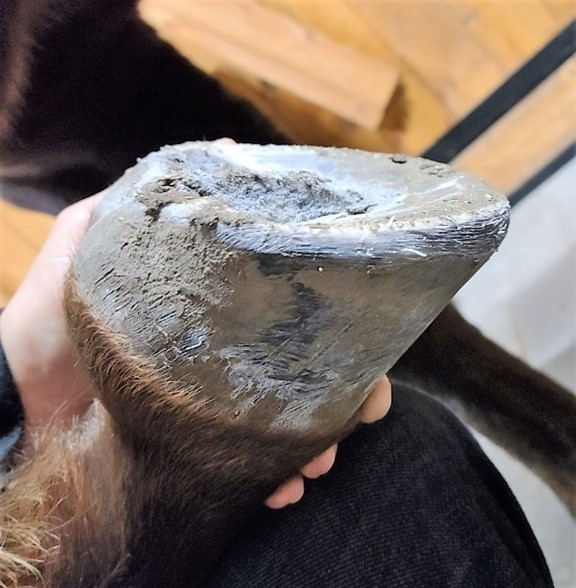

Let’s allow the brilliance of the hoof to function at full capacity whenever possible.
Assessing the Natural Trim
The first step in natural hoof care is to determine the best trim for natural balance. Hooves with optimal balance are healthy and sound on all terrain. Thus, the barefoot trimmer is continually working toward this level of soundness for the horse. The initial assessment is guided by reading the needs of the horse through their movement patterns, postural development, and how they wear their hooves. Barefoot trimmers also follow the markers of the internal structures of the hoof. These markers include the length of the frog, the depth of concavity, and the “healing angle” which is the upper 1/8 of the hoof where it grows down from the coronet band. All of these markers allow the trimmer to assess the balance and health of the individual hoof for each horse.
These methods of assessment also enable the trimmer to determine where the excessive growth is, what problems it is causing, and how much should be removed. Excess growth is mostly seen on the heels, bars, hoof walls, and toes. The barefoot trimmer does not cut into the hoof to make it look cosmetically appealing or to force a healthy image, such as sole concavity for example. Rather, the hooves are guided into health slowly over several trims. As well, the barefoot trim makes use of shorter trimming cycles of 3-5 weeks.
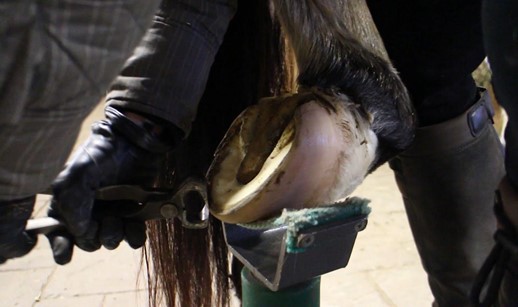
Optimal sole
concavity is never produced with a knife.
Trimming for Strength
Based on this model, achieving dynamic balance of the feet requires the barefoot trimmer to consider the interrelation between the horse’s posture, biomechanics of the limbs and body, muscle development patterns, internal structures, and external structures of each individual hoof. The goal is to heal the hoof and improve its resilience by optimizing this dynamic balance. In this way, the horse eventually grows strong, healthy bare feet without the need for “prosthetics”. Although experienced practitioners may use hoof boots, pads, casting, poly-shoes, and other tools as needed. But, if a barefoot trimmer does apply any prosthetic to the hoof, the goal remains to allow the hoof to function as closely as possible to barefoot. The barefoot approach makes it unnecessary to use metal shoes in hoof care whether the horse is in rehab, involved in competitive sports, or ridden for pleasure.
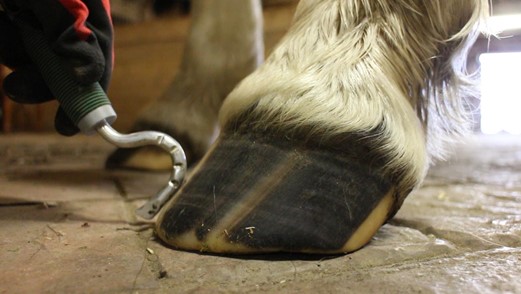
This horse
lives on a 2 km track and is able to move with her herd 24/7.
They walk between slow feeders, limited grass,
tree shade, and water.
She is due for
a trim at 6 weeks, yet the bevel at the toe,
and the solar
arch are still visible.
The Barefoot Career
There are schools and courses designed to train barefoot trimmers. And there are more courses becoming available for people who want to learn how to trim their own horses. However, training courses which bring a trimmer to a competent professional level are harder to come by. And surprisingly, the hoof care profession - barefoot or blacksmith-is not yet governed or supervised in Canada.
I am therefore, currently working closely with other professionals and educators to make hoof care education more accessible in Ontario. This will include a school for professional trimmers, as well as supporting the development of an association to connect and oversee professional barefoot trimmers all across Canada.
The job of a barefoot trimmer is a career that takes passion and precision. It requires hundreds of hours for a trimmer to hone their skills and develop their eye to discover successful approaches with even the most challenging of cases. And many barefoot trimmers offer additional specialties and services for hoof care as well. It is a physically demanding job, and often keeps trimmers up at night problem solving their difficult cases. And many of us work with the owners to develop a full program for growing exceptional feet and happy horses.
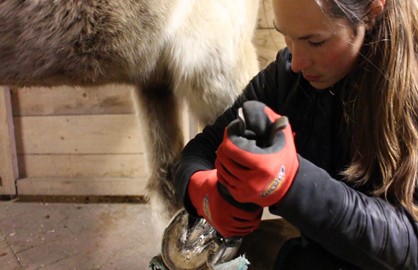
The best trimmers put the horse’s welfare above all else.
Jessica Fobert is a dedicated and passionate Hoof Care Provider. She is certified with both the American Hoof Association and the Progressive Hoof Care Practitioners group. She is the co-founder of an equine rehabilitation centre located North of Toronto, Ontario where she works with a variety of hoof problems and pathologies. Jessica continues to be inspired by the horses she works with and appreciates how important it is to correct all underlying hoof imbalances. As she says, “the foundation of the entire horse is their hooves!”
Click Here for Jessica’s Natural Hoof Care Services

